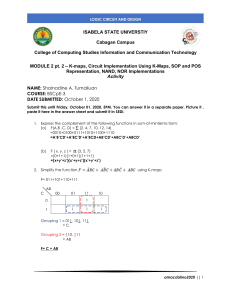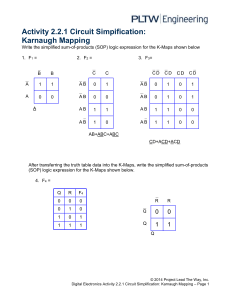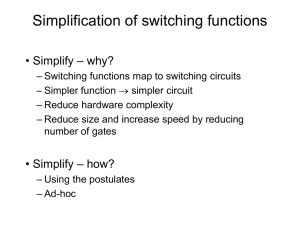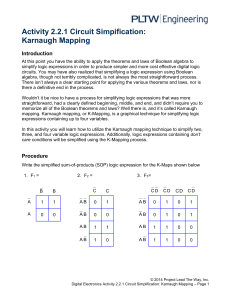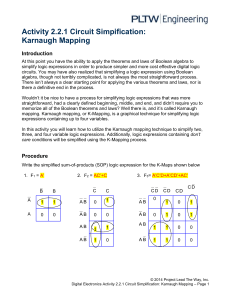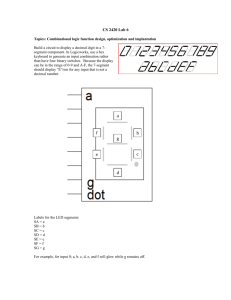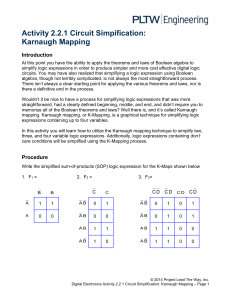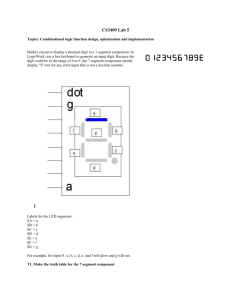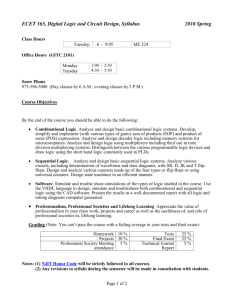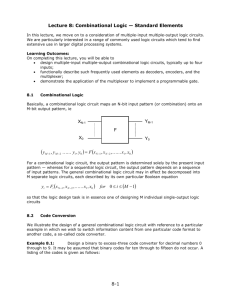Karnaugh Maps (K
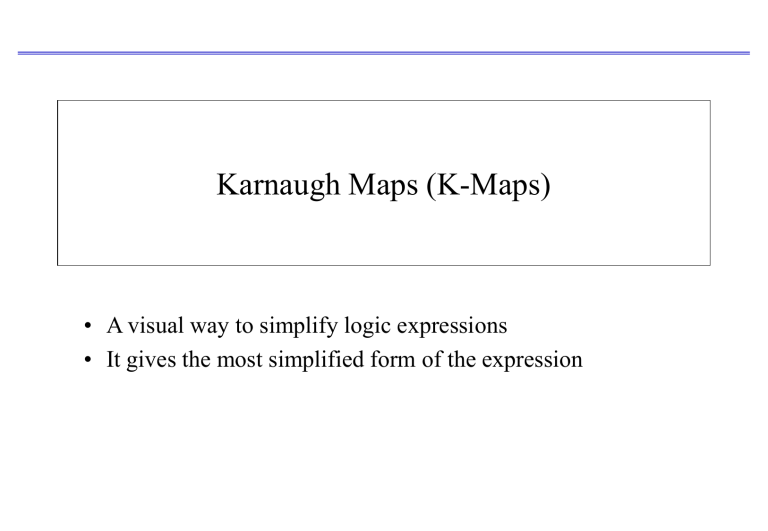
Karnaugh Maps (K-Maps)
• A visual way to simplify logic expressions
• It gives the most simplified form of the expression
Rules to obtain the most simplified expression
•Simplification of logic expression using Boolean algebra is awkward because:
– it lacks specific rules to predict the most suitable next step in the simplification process
– it is difficult to determine whether the simplest form has been achieved.
•A Karnaugh map is a graphical method used to obtained the most simplified form of an expression in a standard form (Sum-of-Products or
Product-of-Sums).
•The simplest form of an expression is the one that has the minimum number of terms with the least number of literals (variables) in each term.
•By simplifying an expression to the one that uses the minimum number of terms, we ensure that the function will be implemented with the minimum number of gates.
•By simplifying an expression to the one that uses the least number of literals for each terms, we ensure that the function will be implemented with gates that have the minimum number of inputs.
3-variable K-maps
• A Karnaugh map is simply a different representation of a truth table:
2
3
0
1
4
5
6
7
0
0
0
0
1
1
1
1
Inputs
A B C
1
1
0
0
0
0
1
1
0
1
0
1
0
1
0
1
Output
X
0
1
0
0
1
1
1
0
A
BC
00
0
01 11 10
1
1 1 1 1
f
(0,4)
B C
A
BC
00
0
01 11 10
1 0 0 0
1 1 0 0 0
Three-Variable K-Maps
f
(4,5)
A B
A
BC
00
0
01 11 10
0 0 0 0
1 1 1 0 0 f
(0,1,4,5)
B
A
BC
00
0
01 11 10
1 1 0 0
1 1 1 0 0 f
(0,1,2,3)
A
A
BC
00
0
01 11 10
1 1 1 1
1 0 0 0 0 f
(0,4)
A C
A
BC
00
0
01 11 10
0 1 1 0
1 0 0 0 0 f
(4,6)
A C
A
BC
00
0
01 11 10
0 0 0 0
1 1 0 0 1 f
(0,2)
A C
A
BC
00
0
01 11 10
1 0 0 1
1 0 0 0 0 f
(0,2,4,6)
C
A
BC
00
0
01 11 10
1 0 0 1
1 1 0 0 1
Simplification using K-maps
• Cover all 1’s
• Use as big groups as possible (fewer variables per term)
• Use as few groups as possible (fewer terms)
• You can use a ‘1’ in more groups than one
A
BC
00
0
01
1
1
1
11 10
1 1
Three-Variable K-Map Examples
A
BC
00
0 1
01 11 10
1 1
1 1 1
A
BC
00
0
01 11 10
1 1
1
1 1
A
BC
00
0
01 11 10
1
1 1 1 1
A
BC
00
0
01 11 10
1 1 1
1 1 1
A
BC
00
0
01 11 10
1
Four-Variable K-Maps
AB
CD
00
00
01 11 10
1 0 0 0
01
11
10
0
0
1
0
0
0
0
0
0
0
0
0 f
(0,8)
B
C
D
AB
CD
00
00
01 11 10
0 0 0 0
01
11
10
0
0
0
1
1
0
0
0
0
0
0
0 f
(5,13)
B
C
D
AB
CD
00
00
01 11 10
0 0 0 0
01
11
10
0
0
0
0
1
0
0
1
0
0
0
0 f
(13,15)
A
B
D
AB
CD
00
00
01 11 10
0 0 0 0
01
11
10
1
0
0
0
0
0
0
0
0
1
0
0 f
(4,6)
A
B
D
AB
CD
00
00
01 11 10
0 0 1 1
01
11
10
0
0
0
0
0
0
1
0
0
1
0
0 f
(2,3,6,7)
A
C
AB
CD
00
00
01 11 10
0 0 0 0
01
11
10
1
1
0
0
0
0
0
0
0
1
1
0 f
(4,6,12,14 )
B
D
AB
CD
00
00
01 11 10
0 0 1 1
01
11
10
0
0
0
0
0
0
0
0
1
0
0
1 f
(2,3,10,11 )
B
C
AB
CD
00
00
01 11 10
1 0 0 1
01
11
10
0
0
1
0
0
0
0
0
0
0
0
1 f
(0,2,8,10)
B
D
Four-Variable K-Maps
AB
CD
00
00
01 11 10
0 0 0 0
01
11
10
1
0
0
1
0
0
1
0
0
1
0
0 f
(4, 5, 6, 7) A B
AB
CD
00
00
01 11 10
0 0 1 0
01
11
10
0
0
0
0
0
0
1
1
1
0
0
0 f
(3, 7,11,15)
AB
CD
00
00
01 11 10
1 0 1 0
01
11
10
0
1
0
1
0
1
0
1
0
1
0
1
AB
CD
00
00
01 11 10
0 1 0 1
01
11
10
1
0
1
0
1
0
1
0
1
0
1
0 f
(0, 3,5, 6, 9,10,12,15) f
A B C D f
(1, 2, 4, 7,8,11,13,14) f
A B C D
AB
CD
00
00
01 11 10
0 1 1 0
01
11
10
0
0
0
1
1
1
1
1
1
0
0
0 f
f
D
(1, 3,5, 7, 9,11,13,15)
AB
CD
00
00
01 11 10
1 0 0 1
01
11
10
1
1
1
0
0
0
0
0
0
1
1
1 f
f
D
(0,2,4,6,8,10,12,14)
AB
CD
00
00
01 11 10
0 0 0 0
01
11
10
1
1
0
1
1
0
1
1
0
1
1
0 f
f
B
(4,5,6,7,12,13,14,15)
AB
CD
00
00
01 11 10
1 1 1 1
01
11
10
0
0
1
0
0
1
0
0
1
0
0
1 f f
B
(0,1,2,3,8,9,10,11)
AB
CD
00
00
1
01 1
01
1
1
11 10
1
1
11 1 1 1
10 1 1
Four-Variable K-Maps Examples
AB
CD
00
00
1
01
1
01
11 10
1
1
11
10
1 1 1
AB
CD
00
00
01 11 10
01
11
10
1
1
1
1
1
1
1
AB
CD
00
00
01
01 11 10
1 1
1 1 1 1
11
10
1 1
1
1
AB
CD
00
00
01 11 10
01
11
10
AB
CD
00
00
01 11 10
01
11
10
AB
CD
00
00
01 11 10
01
11
10
Four-Variable K-Maps Examples
AB
CD
00
00
01 11 10
01
11
10
AB
CD
00
00
01 11 10
01
11
10
AB
CD
00
00
01 11 10
01
11
10
AB
CD
00
00
01 11 10
01
11
10
AB
CD
00
00
01 11 10
01
11
10
AB
CD
00
00
01 11 10
01
11
10
Four-Variable K-Maps Examples
AB
CD
00
00
01 11 10
01
11
10
AB
CD
00
00
01 11 10
01
11
10
AB
CD
00
00
01 11 10
01
11
10
AB
CD
00
00
01 11 10
01
11
10
AB
CD
00
00
01 11 10
01
11
10
Design of combinational digital circuits
• Steps to design a combinational digital circuit:
– From the problem statement derive the truth table
– From the truth table derive the unsimplified logic expression
– Simplify the logic expression
– From the simplified expression draw the logic circuit
• Example: Design a 3-input (A,B,C) digital circuit that will give at its output (X) a logic
1 only if the binary number formed at the input has more ones than zeros.
5
6
3
4
7
0
1
2
1
1
0
1
1
0
0
Inputs
A B C
0 0 0
0
1
1
0
1
0
0
1
1
1
0
1
0
1
1
1
1
0
1
Output
X
0
0
0
X
(3, 5, 6, 7)
A
BC
00
0
01 11 10
0 0 1 0
1 0 1 1 1
X
AC
+
AB
+
BC
A B C
X
Design of combinational digital circuits (Cont.)
• Example: Design a 4-input (A,B,C,D) digital circuit that will give at its output (X) a logic 1 only if the binary number formed at the input is between 2 and 9 (including).
12
13
14
15
8
9
10
11
6
7
4
5
2
3
0
1
0
1
0
1
0
1
0
1
0
1
0
1
0
1
D
0
1
0 1
0 1
1 0
1 0
1 0
1 0
1 1
1 1
1 1
1 1
0
0
Inputs
A B C
0
0
0
0
0 0
0 0
0 1
0 1
0
0
1
1
0
0
1
1
1
1
0
0
1
1
0
0
0
0
0
0
1
1
1
1
Output
X
0
0
1
1
1
1
X
(2,3,4,5,6 ,7,8,9)
AB
CD
00
00
01 11 10
0 0 1 1
01
11
10
1
0
1
1
0
1
1
0
0
1
0
0
X
A C
+
A B
+
A B C
A B C D X
Same
X
Design of combinational digital circuits (Example)
• Example: Design a 4-input (A,B,C,D) digital circuit that will give at its output (X) a logic 1 only if there more ones than zeros in the binary number formed at the input.
12
13
14
15
8
9
10
11
6
7
4
5
2
3
0
1
1
0
1
0
1
1
0
1
0
1
0
1
0
1
0
D
0
0 1
0 1
0 1
1 0
1 0
1 0
1 0
1 1
Inputs
A B C
0 0 0
0 0
0 0
0 0
0 1
1
0
0
1
1 1
1 1
1 1
0
1
1
1
0
0
1
1
0
0
1
Output
X =
X =
AB
CD
00
00
01 11 10
01
11
10
X X
A B C D
